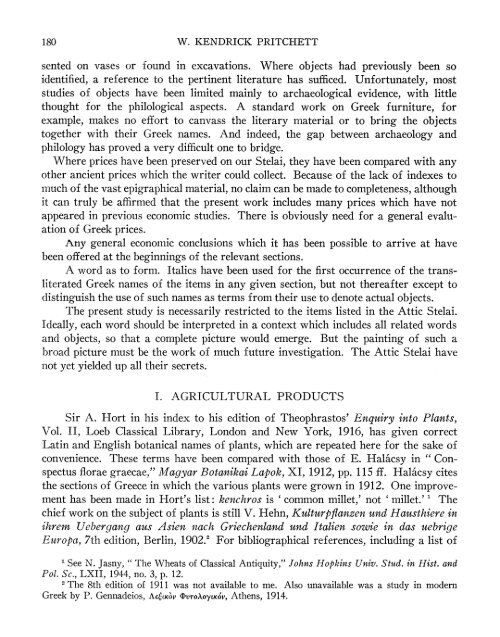the attic stelai - The American School of Classical Studies at Athens
the attic stelai - The American School of Classical Studies at Athens
the attic stelai - The American School of Classical Studies at Athens
You also want an ePaper? Increase the reach of your titles
YUMPU automatically turns print PDFs into web optimized ePapers that Google loves.
180 W. KENDRICK PRITCHETT<br />
sented on vases or found in excav<strong>at</strong>ions. Where objects had previously been so<br />
identified, a reference to <strong>the</strong> pertinent liter<strong>at</strong>ure has sufficed. Unfortun<strong>at</strong>ely, most<br />
studies <strong>of</strong> objects have been limited mainly to archaeological evidence, with little<br />
thought for <strong>the</strong> philological aspects. A standard work on Greek furniture, for<br />
example, makes no effort to canvass <strong>the</strong> literary m<strong>at</strong>erial or to bring <strong>the</strong> objects<br />
toge<strong>the</strong>r with <strong>the</strong>ir Greek names. And indeed, <strong>the</strong> gap between archaeology and<br />
philology has proved a very difficult one to bridge.<br />
Where prices have been preserved on our Stelai, <strong>the</strong>y have been compared with any<br />
o<strong>the</strong>r ancient prices which <strong>the</strong> writer could collect. Because <strong>of</strong> <strong>the</strong> lack <strong>of</strong> indexes to<br />
much <strong>of</strong> <strong>the</strong> vast epigraphical m<strong>at</strong>erial, no claim can be made to completeness, although<br />
it can truly be affirmed th<strong>at</strong> <strong>the</strong> present work includes many prices which have not<br />
appeared in previous economic studies. <strong>The</strong>re is obviously need for a general evalu<strong>at</strong>ion<br />
<strong>of</strong> Greek prices.<br />
Any general economic conclusions which it has been possible to arrive <strong>at</strong> have<br />
been <strong>of</strong>fered <strong>at</strong> <strong>the</strong> beginnings <strong>of</strong> <strong>the</strong> relevant sections.<br />
A word as to form. Italics have been used for <strong>the</strong> first occurrence <strong>of</strong> <strong>the</strong> transliter<strong>at</strong>ed<br />
Greek names <strong>of</strong> <strong>the</strong> items in any given section, but not <strong>the</strong>reafter except to<br />
distinguish <strong>the</strong> use <strong>of</strong> such names as terms from <strong>the</strong>ir use to denote actual objects.<br />
<strong>The</strong> present study is necessarily restricted to <strong>the</strong> items listed in <strong>the</strong> Attic Stelai.<br />
Ideally, each word should be interpreted in a context which includes all rel<strong>at</strong>ed words<br />
and objects, so th<strong>at</strong> a complete picture would emerge. But <strong>the</strong> painting <strong>of</strong> such a<br />
broad picture must be <strong>the</strong> work <strong>of</strong> much future investig<strong>at</strong>ion. <strong>The</strong> Attic Stelai have<br />
not yet yielded up all <strong>the</strong>ir secrets.<br />
I. AGRICULT-URAL PRODUCTS<br />
Sir A. Hort in his index to his edition <strong>of</strong> <strong>The</strong>ophrastos' Enquiry into Plants,<br />
Vol. II, Loeb <strong>Classical</strong> Library, London and New York, 1916, has given correct<br />
L<strong>at</strong>in and English botanical names <strong>of</strong> plants, which are repe<strong>at</strong>ed here for <strong>the</strong> sake <strong>of</strong><br />
convenience. <strong>The</strong>se terms have been compared with those <strong>of</strong> E. Halacsy in " Conspectus<br />
florae graecae," Magyar Botanikai Lapok, XI, 1912, pp. 115 ff. Halacsy cites<br />
<strong>the</strong> sections <strong>of</strong> Greece in which <strong>the</strong> various plants were grown in 1912. One improvement<br />
has been made in Hort's list: kenchros is 'common millet,' not 'millet.'" <strong>The</strong><br />
chief work on <strong>the</strong> subject <strong>of</strong> plants is still V. Hehn, Kulturpflanzen und Hausthiere in<br />
ihrem Uebergang aus Asien nach Griechenland und It alien sowie in dais uebrige<br />
Europa, 7th edition, Berlin, 1902.2 For bibliographical references, including a list <strong>of</strong><br />
1 See N. Jasny, " <strong>The</strong> Whe<strong>at</strong>s <strong>of</strong> <strong>Classical</strong> Antiquity," Johns Hopkins Univ. Stud. in Hist. and<br />
Pol. Sc., LXII, 1944, no. 3, p. 12.<br />
2<strong>The</strong> 8th edition <strong>of</strong> 1911 was not available to me. Also unavailable was a study in modern<br />
Greek by P. Gennadeios, AEewLKOV 4VTOxo7tKOv, A<strong>the</strong>ns, 1914.
















